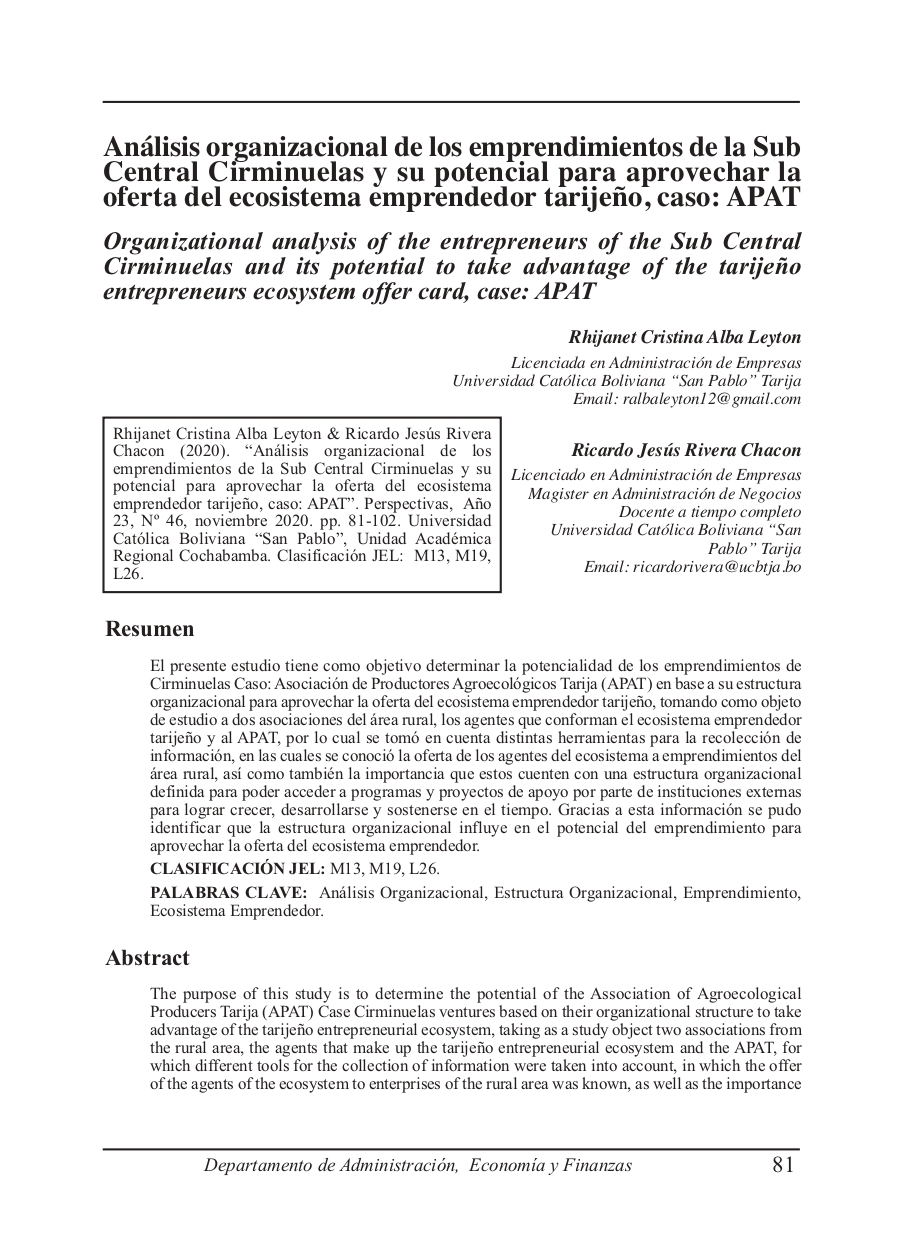Análisis organizacional de los emprendimientos de la Sub Central Cirminuelas y su potencial para aprovechar la oferta del ecosistema emprendedor tarijeño, caso: APAT
DOI:
https://doi.org/10.35319/vxr76q31Palabras clave:
Análisis Organizacional, Estructura Organizacional, Emprendimiento, Ecosistema EmprendedorResumen
El presente estudio tiene como objetivo determinar la potencialidad de los emprendimientos de Cirminuelas Caso: Asociación de Productores Agroecológicos Tarija (APAT) en base a su estructura organizacional para aprovechar la oferta del ecosistema emprendedor tarijeño, tomando como objeto de estudio a dos asociaciones del área rural, los agentes que conforman el ecosistema emprendedor tarijeño y al APAT, por lo cual se tomó en cuenta distintas herramientas para la recolección de información, en las cuales se conoció la oferta de los agentes del ecosistema a emprendimientos del área rural, así como también la importancia que estos cuenten con una estructura organizacional definida para poder acceder a programas y proyectos de apoyo por parte de instituciones externas para lograr crecer, desarrollarse y sostenerse en el tiempo. Gracias a esta información se pudo identificar que la estructura organizacional influye en el potencial del emprendimiento para aprovechar la oferta del ecosistema emprendedor.
Descargas
Referencias
Agudelo, Z. L. (2017). Los ecosistemas como parte de la estrategia de desarrollo de una región.
Alcatraz Rodriguez, R. (2011). El emprendedor del éxito. México: McHill Graw. Obtenido de http://catarina.udlap.mx/u_dl_a/tales/documentos/lad/lopez_t_cr/capitulo1.pdf
Alcobendas, A. d. (2012). Alcobendas. Obtenido de http://asociaciones.alcobendas.org/que-es-una-asociacion/
Alcover, Martinez, Rodriguez & Dominguez. (2012). Administración de Personal. México.
Benjamin & Fincowsky. (2009). Organización de Empresas. México: McGraw Hill.
Blau, M. (2002). Gestiopolis. Obtenido de https://www.gestiopolis.com/la-estructura-organizacional/
Bustillo, G. (20 de septiembre de 2016). Correo del Sur.
Chiavenato. (2006). En I. Chiavenato, Introducción a la Teoría General de la Administración (págs. 2 y 160 al 172). McGraw-Hill.
Chiavenato. (2007). Administración de Recursos Humanos. México: McGraw Hill.
Chiavenato. (2009). En Chiavenato, Comportamiento Organizacional (págs. 94 -95). México: McGraw Hill.
Española, R. A. (1925). Asociación de academias de la lengua española. Obtenido de https://dle.rae.es/?id=6xqCnDZ|6xxQ4ub
Ferrel O., Hirt, Ramos, Adriaensens & Flores. (2004). En H. G. Ferrel O.C., Introducción a los Negocios en un Mundo Cambiante (págs. 251 y 252). McGraw-Hill Interamericana.
Figueroa, M. A. (2016). En busca de un ecosistema emprendedor. Página Siete.
Freire, A. (2004). Pasión por emprender. Argentina: Aguilar.
Ibañez. (2001). Emprender - Marco Teórico.
Instituto Nacional de Estadística. (abril de 2017). Instituto Nacional de Estadística.
Isenberg, D. (2010). Dominios del ecosistema. Harvard Business Review.
Isenberg, D. (2014). Ecosistema del emprendedor. En G. Barja, Ecosistema del emprendedor por subsistencia paceño. La Paz.
Kantis, H. (2016). En busca del ecosistema emprendedor. Página Siete, pág. 8.
Mancha, F. C.-L. (s.f.). Castilla - La Mancha. Obtenido de https://ejuridicas.castillalamancha.es/asociaciones/definicion-asociacion
McClelland, Kuriloff, Hemphill, & DEMAC. (2011). El emprendedor del éxito. México: McGraw Hill.
Michael, Stewart & Lyman. (2006). Administración. En B. S. Michael Hitt. México: Pearson Educación México.
Moore, J. (1993). Depredadores y presas: una nueva ecología de la competencia. Harvard Business Review.
Parada, L. A. (2015). Innovación Bolivia. Obtenido de http://innovacionbolivia.blogspot.com/2011/05/emprendedurismo-en-bolivia.html
Querejazu, V., Zavleta, D., & Mendizabal, J. (2014). Global Entrepreneurship Monitor. La Paz.
Rivera, D. (26 de abril de 2019). Prado cifra en 7% el desempleo en Tarija, lanza plan “urgente”. El País.
Rodriguez, A. (2011). Características del emprendedor. En R. Alcatraz Rodriguez, El emprendedor del éxito (págs. 2 - 3). México: McHill Graw.
Salazar, F. (2013). Repositorio UADE. Obtenido de https://repositorio.uade.edu.ar/xmlui/bitstream/handle/123456789/408/CDS12020143.pdf?sequence=1&isAllowed=y
Schein. (2013). Obtenido de http://sedici.unlp.edu.ar/bitstream/handle/10915/32511/Documento_completo.pdf?sequence=2&isAllowed=y
Schnarch, A. (2014). Emprendimiento Exitoso. Ecoe.
Schnarch, A. (2017). De Gerencia. Obtenido de https://degerencia.com/articulo/emprendimiento-innovacion-e-informacion/
Shashin, R. (2007). Entrepreneur. Obtenido de https://www.entrepreneur.com/article/258561
Tarqui Ayala, F., Meza Lora, N., Alvarez Gomez, E., Cisneros Uria, D., & Barja Daza, G. (2017). Ecosistema del Emprendedor por Subsistencia Paceño. (G. Barja, Ed.) La Paz, Bolivia: SOIPA.
Vlir Uos. (2019). Criterios para la selección de la microrregión e identificación de posibles áreas temáticas vinculadas a los proyectos del programa VLIR OUS1. Tarija.
Wortman. (1990). COMUNIICA. Obtenido de https://onlinelibrary.wiley.com/doi/abs/10.1002/1520-6297%28199007%296%3A4%3C329%3A%3AAID-AGR2720060405%3E3.0.CO%3B2-N

Descargas
Publicado
Número
Sección
Licencia
Derechos de autor 2020 Revista Perspectivas

Esta obra está bajo una licencia internacional Creative Commons Atribución-NoComercial-CompartirIgual 4.0.
La Revista Perspectivas de la Universidad Católica Boliviana, es una revista de acceso abierto, por lo tanto, es de libre acceso en su integridad. Está permitida su lectura, búsqueda, descarga, distribución y reutilización legal en cualquier tipo de soporte únicamente para fines no comerciales, siempre y cuando la obra sea debidamente citada.




